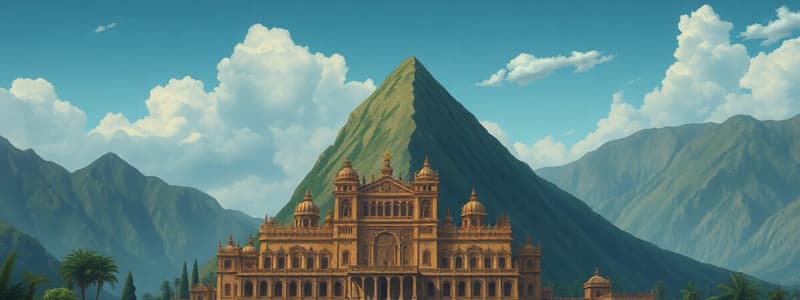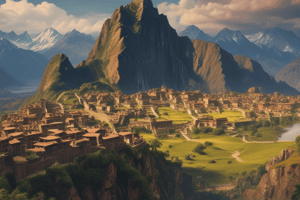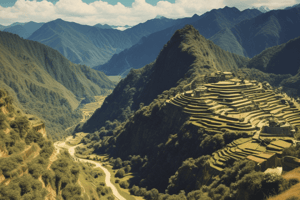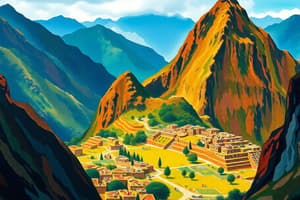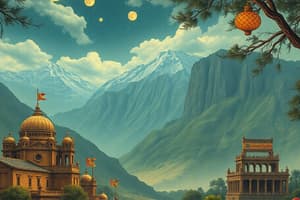Podcast
Questions and Answers
Which of the following best describes the role of the Sapa Inca in Inca society?
Which of the following best describes the role of the Sapa Inca in Inca society?
- A military general responsible for leading the Inca army.
- The emperor, who was considered a god. (correct)
- The high priest in charge of interpreting messages from the Oracle.
- A messenger responsible for delivering messages throughout the empire.
The Inca Empire utilized which innovative farming technique to cultivate crops in the mountainous terrain of the Andes?
The Inca Empire utilized which innovative farming technique to cultivate crops in the mountainous terrain of the Andes?
- Crop rotation using various plant species.
- Terraces, that created flat platforms for agriculture. (correct)
- Slash and burn agriculture, that cleared land for crops.
- The use of irrigation systems to flood plains.
What was the primary function of the Inca road system?
What was the primary function of the Inca road system?
- To serve as a defensive barrier against invasions.
- To facilitate trade with neighboring civilizations.
- To connect the empire for communication and transportation. (correct)
- To delineate the boundaries of the Inca Empire.
What was the significance of the Quipu in Inca society?
What was the significance of the Quipu in Inca society?
Which country was NOT part of the Inca Empire?
Which country was NOT part of the Inca Empire?
What role did the Mit'a system play in the Inca Empire?
What role did the Mit'a system play in the Inca Empire?
What was the main outcome of Francisco Pizarro's arrival in 1532?
What was the main outcome of Francisco Pizarro's arrival in 1532?
What geographic feature provided a natural defense for the Inca Empire?
What geographic feature provided a natural defense for the Inca Empire?
Flashcards
Sapa Inca
Sapa Inca
The emperor of the Inca Empire, believed to be a god.
Ayllu
Ayllu
A family clan or extended kin group in Inca society.
Mit'a
Mit'a
Mandatory labor service owed to the Inca Empire.
Inti
Inti
Signup and view all the flashcards
Oracle
Oracle
Signup and view all the flashcards
Huaca
Huaca
Signup and view all the flashcards
Chaski
Chaski
Signup and view all the flashcards
Quipu
Quipu
Signup and view all the flashcards
Study Notes
- The Inca empire included parts of Ecuador, Colombia, Bolivia, Chile, and Argentina.
- Only the southern region of Colombia was influenced by the Incas.
- Bolivia contained many key Inca settlements.
- The empire extended into northern Chile.
- The Inca controlled parts of northwest Argentina.
Important Dates
- 1200s: Inca civilization began in the Andes.
- 1438: Pachacuti significantly expanded the empire.
- 1532: Francisco Pizarro, a Spanish conquistador, arrived.
- 1533: The Inca Empire fell after Atahualpa was captured and executed.
- 1572: The final Inca resistance ended at Vilcabamba.
Physical Geography
- The Inca Empire's geography was both challenging and beneficial.
- Andes Mountains: High-altitude, rugged terrain provided natural defense.
- Amazon Rainforest: Dense jungle bordered the eastern part of the empire.
- Pacific Ocean: Formed the western boundary.
- Terraces: Stepped agricultural fields built on mountain slopes for farming.
- Inca Road System: Over 24,000 miles of roads connected the empire.
- Machu Picchu: A famous Inca city possibly used as a royal estate or religious center.
- Intihuatana: A stone used as a sun calendar to track the seasons.
Key Vocabulary
Government & Society
- Sapa Inca: The emperor, considered a god.
- Ayllu: A family clan or extended kin group.
- Mit’a: A system of mandatory labor service to the empire.
- Dynasty: A powerful ruling family that stays in control for generations.
Religion & Culture
- Inti: The Sun God, the most important deity.
- Oracle: A priest/priestess who communicated messages from the gods.
- Huaca: A sacred object or location in Inca religion.
- Chimus: A mother culture of the Inca Empire, influencing their traditions.
Technology & Communication
- Chaski: Messengers who ran long distances to deliver messages.
- Quipu: A knotted string system used for counting and record-keeping.
- Aqueduct: A structure used to transport water, similar to irrigation.
- Intihuatana: Inca Sun Calendar used for astronomy.
Animals & Farming
- Beast of Burden: An animal used for carrying loads (e.g., llamas).
- Terraces: Stepped agricultural fields carved into mountains for farming.
Studying That Suits You
Use AI to generate personalized quizzes and flashcards to suit your learning preferences.
Description
Explore the Inca Empire's expansion across Ecuador, Colombia, Bolivia, Chile, and Argentina. Key dates include the empire's rise in the 1200s, expansion in 1438, and fall in 1533. The empire spanned the Andes Mountains, Amazon Rainforest, and Pacific Ocean.
